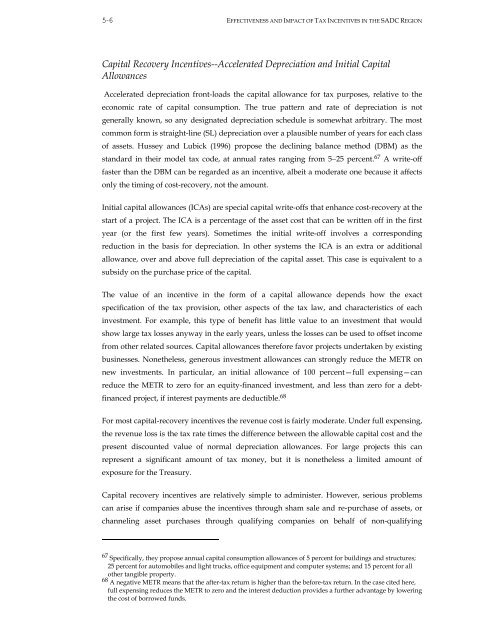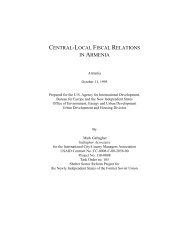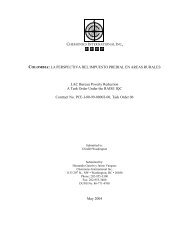Effectiveness and Economic Impact of Tax Incentives in the SADC ...
Effectiveness and Economic Impact of Tax Incentives in the SADC ...
Effectiveness and Economic Impact of Tax Incentives in the SADC ...
Create successful ePaper yourself
Turn your PDF publications into a flip-book with our unique Google optimized e-Paper software.
5-6 EFFECTIVENESS AND IMPACT OF TAX INCENTIVES IN THE <strong>SADC</strong> REGION<br />
Capital Recovery <strong>Incentives</strong>--Accelerated Depreciation <strong>and</strong> Initial Capital<br />
Allowances<br />
Accelerated depreciation front-loads <strong>the</strong> capital allowance for tax purposes, relative to <strong>the</strong><br />
economic rate <strong>of</strong> capital consumption. The true pattern <strong>and</strong> rate <strong>of</strong> depreciation is not<br />
generally known, so any designated depreciation schedule is somewhat arbitrary. The most<br />
common form is straight-l<strong>in</strong>e (SL) depreciation over a plausible number <strong>of</strong> years for each class<br />
<strong>of</strong> assets. Hussey <strong>and</strong> Lubick (1996) propose <strong>the</strong> decl<strong>in</strong><strong>in</strong>g balance method (DBM) as <strong>the</strong><br />
st<strong>and</strong>ard <strong>in</strong> <strong>the</strong>ir model tax code, at annual rates rang<strong>in</strong>g from 5−25 percent. 67 A write-<strong>of</strong>f<br />
faster than <strong>the</strong> DBM can be regarded as an <strong>in</strong>centive, albeit a moderate one because it affects<br />
only <strong>the</strong> tim<strong>in</strong>g <strong>of</strong> cost-recovery, not <strong>the</strong> amount.<br />
Initial capital allowances (ICAs) are special capital write-<strong>of</strong>fs that enhance cost-recovery at <strong>the</strong><br />
start <strong>of</strong> a project. The ICA is a percentage <strong>of</strong> <strong>the</strong> asset cost that can be written <strong>of</strong>f <strong>in</strong> <strong>the</strong> first<br />
year (or <strong>the</strong> first few years). Sometimes <strong>the</strong> <strong>in</strong>itial write-<strong>of</strong>f <strong>in</strong>volves a correspond<strong>in</strong>g<br />
reduction <strong>in</strong> <strong>the</strong> basis for depreciation. In o<strong>the</strong>r systems <strong>the</strong> ICA is an extra or additional<br />
allowance, over <strong>and</strong> above full depreciation <strong>of</strong> <strong>the</strong> capital asset. This case is equivalent to a<br />
subsidy on <strong>the</strong> purchase price <strong>of</strong> <strong>the</strong> capital.<br />
The value <strong>of</strong> an <strong>in</strong>centive <strong>in</strong> <strong>the</strong> form <strong>of</strong> a capital allowance depends how <strong>the</strong> exact<br />
specification <strong>of</strong> <strong>the</strong> tax provision, o<strong>the</strong>r aspects <strong>of</strong> <strong>the</strong> tax law, <strong>and</strong> characteristics <strong>of</strong> each<br />
<strong>in</strong>vestment. For example, this type <strong>of</strong> benefit has little value to an <strong>in</strong>vestment that would<br />
show large tax losses anyway <strong>in</strong> <strong>the</strong> early years, unless <strong>the</strong> losses can be used to <strong>of</strong>fset <strong>in</strong>come<br />
from o<strong>the</strong>r related sources. Capital allowances <strong>the</strong>refore favor projects undertaken by exist<strong>in</strong>g<br />
bus<strong>in</strong>esses. None<strong>the</strong>less, generous <strong>in</strong>vestment allowances can strongly reduce <strong>the</strong> METR on<br />
new <strong>in</strong>vestments. In particular, an <strong>in</strong>itial allowance <strong>of</strong> 100 percent—full expens<strong>in</strong>g—can<br />
reduce <strong>the</strong> METR to zero for an equity-f<strong>in</strong>anced <strong>in</strong>vestment, <strong>and</strong> less than zero for a debt-<br />
f<strong>in</strong>anced project, if <strong>in</strong>terest payments are deductible. 68<br />
For most capital-recovery <strong>in</strong>centives <strong>the</strong> revenue cost is fairly moderate. Under full expens<strong>in</strong>g,<br />
<strong>the</strong> revenue loss is <strong>the</strong> tax rate times <strong>the</strong> difference between <strong>the</strong> allowable capital cost <strong>and</strong> <strong>the</strong><br />
present discounted value <strong>of</strong> normal depreciation allowances. For large projects this can<br />
represent a significant amount <strong>of</strong> tax money, but it is none<strong>the</strong>less a limited amount <strong>of</strong><br />
exposure for <strong>the</strong> Treasury.<br />
Capital recovery <strong>in</strong>centives are relatively simple to adm<strong>in</strong>ister. However, serious problems<br />
can arise if companies abuse <strong>the</strong> <strong>in</strong>centives through sham sale <strong>and</strong> re-purchase <strong>of</strong> assets, or<br />
channel<strong>in</strong>g asset purchases through qualify<strong>in</strong>g companies on behalf <strong>of</strong> non-qualify<strong>in</strong>g<br />
67 Specifically, <strong>the</strong>y propose annual capital consumption allowances <strong>of</strong> 5 percent for build<strong>in</strong>gs <strong>and</strong> structures;<br />
25 percent for automobiles <strong>and</strong> light trucks, <strong>of</strong>fice equipment <strong>and</strong> computer systems; <strong>and</strong> 15 percent for all<br />
o<strong>the</strong>r tangible property.<br />
68 A negative METR means that <strong>the</strong> after-tax return is higher than <strong>the</strong> before-tax return. In <strong>the</strong> case cited here,<br />
full expens<strong>in</strong>g reduces <strong>the</strong> METR to zero <strong>and</strong> <strong>the</strong> <strong>in</strong>terest deduction provides a fur<strong>the</strong>r advantage by lower<strong>in</strong>g<br />
<strong>the</strong> cost <strong>of</strong> borrowed funds.











